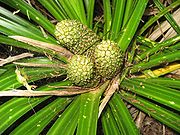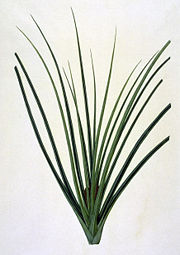.gif)
Kiekie (plant)
Encyclopedia


New Zealand
New Zealand is an island country in the south-western Pacific Ocean comprising two main landmasses and numerous smaller islands. The country is situated some east of Australia across the Tasman Sea, and roughly south of the Pacific island nations of New Caledonia, Fiji, and Tonga...
. It is a member of the screwpalm family Pandanaceae
Pandanaceae
Pandanaceae is a family of flowering plants native to the tropics of the Old World. Such a family has been widely recognized by taxonomists.Pandanaceae are trees or climbing or scrambling shrubs distributed in the Old World tropics and are adapted from sea level in salted beaches to mountain cloud...
.
Kiekie has numerous cane-like stems up to 40 mm in diameter, which freely produce aerial roots. It climbs tree trunks, or forms dense tangles on the forest floor. Its stems and leaves are a dominant feature in many areas of New Zealand forest, the stems eventually reaching up to 30 m long. The leaves
Leaf
A leaf is an organ of a vascular plant, as defined in botanical terms, and in particular in plant morphology. Foliage is a mass noun that refers to leaves as a feature of plants....
are long and slender, 60-90 cm long and 2-2.5 cm broad.
Distribution
Kiekie is found in forests throughout the North IslandNorth Island
The North Island is one of the two main islands of New Zealand, separated from the much less populous South Island by Cook Strait. The island is in area, making it the world's 14th-largest island...
. In the South Island
South Island
The South Island is the larger of the two major islands of New Zealand, the other being the more populous North Island. It is bordered to the north by Cook Strait, to the west by the Tasman Sea, to the south and east by the Pacific Ocean...
, kiekie is more common in higher rainfall areas, reaching its southern limit near the Clarence river in the east and in Fiordland
Fiordland
Fiordland is a geographic region of New Zealand that is situated on the south-western corner of the South Island, comprising the western-most third of Southland. Most of Fiordland is dominated by the steep sides of the snow-capped Southern Alps, deep lakes and its ocean-flooded, steep western valleys...
in the west.
Classification
In 1973, B.C. Stone argued that F. banksii should be regarded as a subspecies of F. baueriana of Norfolk Island (Stone 1973). Subsequent to this, de Lange et al. (2005:591-592), countered Stone's arguments and retained F. banksii as a distinct species because of significant differences from F. baueriana, including over all growth habit, phyllotaxis, leaf width, vein tesellation, and bract colour (salmon pink to orange in F. baueriana, white to purplish in F. banksii).Uses
The sweet-tasting fruits and the succulent flower bracts (tāwhara) were a delicacy of the Māori. These were often gathered by using a forked stick. The leaves widely for plaiting and weaving, although the broader leaves of New Zealand flaxNew Zealand flax
New Zealand flax describes common New Zealand perennial plants Phormium tenax and Phormium cookianum, known by the Māori names harakeke and wharariki respectively...
were preferred because they provided more material. Items woven included mats and temporary baskets for holding food. The aerial roots were gathered to use as a binding material for implements and for making fish traps and sandals.

